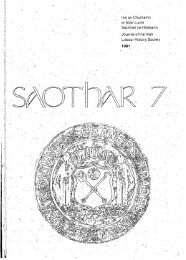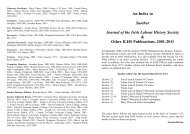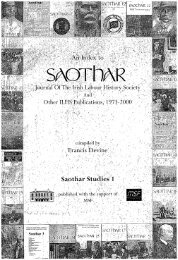96 SAOTHAR13evidence of political conservatism on their part. Some Irish-Catholics - who were otherwise sympatheticto Maclean - were probably alienated at a mass eve-of-the-poll rally where Maclean said: 'Therewere two Jews - Jesus Christ and Karl Marx.One appealed to the heart and the other appealed to thehead' .55 Yet despite the most obvious political feature of the Irish immigrants' sub-culture - that is,the Catholicism which often made them more radical, yet divided from the Scottish workers on somesocial issues - the Easter Rising ended the Irish question in Scottish politics by creating the Anglo-IrishTreaty in 1921.At the same time as they supported Irish independence, John Leslie and John L. Mahon dissociatedthemselves from bourgeois Sinn Fein and the Easter Rising and asked Irish-Catholics to vote Labour.Whilst the process of social assimilation was not complete, the dual-identity of Irish immigrants wasnow reinforcing the still evolving class solidarity of the Irish and the indigenous Scots. In the dramaticelectoral breakthrough in the general election of 1922, John Wheatley, Hugh Murin and Joseph Sullivan(1866-1935) were elected as champions of the Scottish working class .. Certainly; there were setbacks; and in the general election of 1924 J oseph Sullivan lost his seat inParliament as the result of an Orange backlash in the North Lanarkshire constituency. But elsewherein Scotland the militant Irish-Catholic immigrants played a new role in the labour movement andassisted their own assimilation into working class Scotland. In 1922 the Irish-Catholic immigrantshelped to elect Emanuel Shinwell in the West Lothian constituency. By 1924 the Irish-Catholicimmigrants were accepting their class identity within Scotland; the Catholic Socialist Society waswound up and absorbed by the wider Scottish labour movement. 56Although the dual-identity of the Irish immigrants was evident from at least the 1880s, it was notinconsistent with, indeed was sometimes a force for, activism in Scottish working class politics. AlsothIs dual-identity ultimately facilitated Irish incorporation into the Scottish labour movement. Thisconclusion is consistent with the observation made by Joan Smith that working class support forLiberalism in Glasgow before the First World War helped to contain 'the Protestant-Catholic divide'.It is also compatible with Patrick Renshaw' s assertion that the supporters and advocates of the IndustrialWorkers of Great Britain (IWGB) were either Scottish, Irish, or Welsh, the' 'immigrant' workers fromthe Celtic fringe'. By 1926 the Scottish workers - or rather the minority of them involved in politics -entered the General Strike as a more unified political force than they had been at any time since 1880.The dual identity of the Irish immigrants had played an important role in this new development. 5 ?NotesJames D. Young1. John GaIt was allegedly the first of the Kailyard novelists. Kailyard propagandists asserted that Scotland wasa democratic society with an almost irmate 'democratic intellect', a rural idyll remote from strife or classconflict. The Kailyard was, however, threatened by the Irish-Catholic immigrants. As one influential Scottishhistorian put it: 'Scottish democracy was the ideological basis of the Liberal Party in Scotland, but it couldnot apply to the Irish, Roman Catholic, uneducated, and not too concerned with the digni ties of man in the faceof struggle for survival, the Irish working class (and there were not many in any other class) seemed a threatto the Scottish way of life '. James G. Kellas, 'The Development of the Liberal Party in Scotland., 1868-1895' ,.PhD, University of London, 1966, p. 26.2. M. Flinn (ed.) Scottish Population Historyfrom the 17th Century to the 1930s, (Cambridge, 1977), p.303 andp.365.3. James Handley, The Irish in Scotland, (Glasgow, 1950), p. 348.4. Robert Haddow, 'The Miners of Scotland', The Nineteenth Century, September 1888, pp. 360-368. In aninteresting description of the sexual jealousy between the Scottish and Irish-Catholic immigrants, T.e. Smoutsaid: 'Indeed, sometimes Irishmen were guilty of precisely the same double-standard as the middle-classScottish male: Patrick MacGill in his remarkable autobiographical novels oflife among Irish harvest workersin Scotland described how experienced men would go with Scottish prostitutes but condemn with horror a
ESSAYS 97young girl of their own band who had been seduced by a farmer's son'. T.C. Smout, 'Aspects of SexualBehaviour in Nineteenth Century Scotland', in A. Allan MacLaren (ed.), Social Class in Scotland: Past andPresent, (Edinburgh, 1975), p. 73.5. T.C. Smout, A Century of the Scottish People, (London, 1987), p. 258.6. lan S. Wood, 'Irish Nationalism and Radical Politics in Scotland, 1880-1906' ,Journal of the Scottish LabourHistory Scoiety, No. 9, 1975, P. 21.7. Labour Standard, 13 August, 1881. James D. Young, 'Working Class and Radical Movement in Scotland andthe Revolt from Liberalism, 1866-1900', PhD thesis, University of Stirling, 1974,passim.8. The Exile, 16 May, 1885.9, Smout, op.cit., p. 238. .10. Eric J. Hobsbawm, 'Working Classes and Nations', Saothiir 8,1982, pp. 75-85.11. In the early 1880s William Small and Catholic priests founded the Scottish Anti-Royalty and Labour Leaguein Hamilton. 'In the coalfields of the East of Scotland, where there were few Roman Catholic miners of Irishorigin, socialism was halted for a few more years. But in the coalfields of the West of Scotland, where a numberof Roman Catholic miners were active in the branches of the Irish National League, socialism spread likewildfIre'. James D. Young, 'Changing Images of American Democracy and the Scottish Labour Movement,1866-1900' International Review of Social History, Vol. XVII/, Part I, 1973, p. 82.12. S. V. Bracher, The Herald Book of Labour Members, (London, 1923), p. 179.13. Interview with Tom Murray, veteran Communist Party organiser in Edinburgh, 3 April, 1980 and interviewwith Bobby Baird, veteran member of the Independent Labour Party in Falkirk, 4 December, 1987.14. For example, see R. Archer's commentary on the writings of Franz Mehring: 'Here, especially in the extractsfrom the Lessing Legend, he shows that the way individuals see themselves is itself part of their social being'.Dr. Archer, 'Foreward', Franz Mehring, Absolutism and Revolution in Germany, 1525-1848, (London, 1975),p. xiii. .15. A Traveller Underground,OurCoal and Coal-Pits, the People in Them and theScenesAroundThem, (London,1956), p. 224.16: lan S. Wood, op.cit., pp. 21-38.17. H.W. Lee and E. Archbold, Social-Democracy in Britain, (London, 1935), p. 144.18. James Handley, The Irish in Modern Scotland, (Cork, 1947), p. 320.19. Robert Srnillie, My Life for Labour, (London, 1924), pp. 15-22.20. Glasgow Sentinel, 21 July, 1877.21. William Stewart,l. Keir Hardie, (London, 1921), p. 11.22. Wood, op.cit., p. 21.23. Letter from the Right Rev. Monsignor David Roberts in response to information that I sought about John L.Mahon's place of baptism, dated 24 May, 1969. There is also considerable information on Mahon in theSocialist League Archives, International Institute of Social History, Amsterdam. See also E. P. Thompson,William Morris: Romantic to Revolutionary, (London, 1955), passim.24. When I interviewed Bob Selkirk, the veteran Scottish communist on 3 April, 1971, he told me that FredDouglas, a foundation member of the Communist Party in Edinburgh, was the son of lrish-Catholicimmigrants .25. Bill Knox (ed.), 'Hugh Murin', Biographical Dictionary of Scottish Labour Leaders, (Edinburgh, 1983).'Born in Glasgow, 1860, ofIrish parents. At 11 (PeteCurran) commenced work in blacksmith's shop. JoinedIrish Land League in Glasgow, 1880; afterwards Scottish Land Restoration League founded by HenryGeorge'. Labour Annual (London, 1896).26. James D. Young, 'The Rise of Scottish Socialism', in Gordon Brown (ed.), The Red Paper on Scotland,(Edinburgh, 1975).27. 'William Small', Glasgow Herald, 24 January, 1903.28. Fred Reid, Keir Hardie: The Making of a Socialist, (London, 1978), p. 95.29. 'John Murdoch', The Scotsman, 2 February, 1903; James D. Young, 'John Murdoch: Scottish Land andLabour Pioneer', Bulletin of the Society for the Study of Labour History, No. 19, 1969; 'Death of JohnMurdoch', Glasgow Weekly Herald, 7 February, 1903.30. Bella Smalls' Papers on her father, WiIliam Small, and her annotation on page 21 of Lowe's Souvenirs ofScottish Labour and on The Independent Labour Party, 1893-1943: Jubilee Souvenir; manuscript memoirby William Small; and manuscript memoirs by his daughter and Andrew McCowie. William Small Papers,National Library of Scotland, Ms. Ace. 3359.31. 'J. Shaw Maxwell was born about 1855 near Salkrnarket of Glasgow; a lithographic designer by trade; hemarried at 21; wa.s secretary of the Glasgow Socialist Society, joined Irish Land League about 1880'. Labour
- Page 1 and 2:
JOURNAL OF THE IRISH LABOUR HISTORY
- Page 3 and 4:
ContentsPageEditorial: Labour Histo
- Page 5 and 6:
EDITORIAL 3freedom to participate i
- Page 7 and 8:
CorrespondenceThe Irish Labour Part
- Page 9 and 10:
; ~ ; ,The Decline and Fall of Donn
- Page 11 and 12:
THE DECLINE AND FALL OF DONNYBROOK
- Page 13 and 14:
THE DECLINE AND FALL OF DONNYBROOK
- Page 15 and 16:
·' THE DECLINE AND FALL OF DONNYBR
- Page 17 and 18:
THE DECLINE AND FALL OF DONNYBROOK
- Page 19 and 20:
THE DECLINE AND FALL OF DONNYBROOK
- Page 21 and 22:
THE DECLINE AND FALL OF DONNYBROOK
- Page 23 and 24:
THE DECLINE AND FALL OF DONNYBROOK
- Page 25 and 26:
,'-,;-''''.A PASSAGE TO BRITAIN 23C
- Page 27 and 28:
A PASSAGE TO BRITAIN 25only in the
- Page 29 and 30:
A PASSAGE TO BRITAIN 27clothing._De
- Page 31 and 32:
A PASSAGE TO BRITAIN 29established
- Page 33 and 34:
;:-.",.- .. .", ...... '.:. '
- Page 35 and 36:
LOUIE BENNETI 33feminist movement w
- Page 37 and 38:
:... ~: ."
- Page 39 and 40:
-.- '.LOUlE BENNETT 37While there i
- Page 41 and 42:
LOUIE ~ENNEIT 39Xl's encyclical Qua
- Page 43 and 44:
LOUIE BENNEIT 41Bennett's own relat
- Page 45 and 46:
LODIE BENNETT 43109; IWWU resolutio
- Page 47 and 48: Essays in ReviewCosherers, Wanderer
- Page 49 and 50: ••• .".'. >. '~"ESSA YS IN RE
- Page 51 and 52: ESSAYS IN REVIEW 49ConnolIy:Myth an
- Page 53 and 54: ESSAYS IN ~EVIEW 51tion' in the Int
- Page 55 and 56: ESSAYS IN REVIEW53International:'I
- Page 57 and 58: REVIEWScontroversy is real history.
- Page 59 and 60: REVIEWSJoe Monks was among the earl
- Page 61 and 62: REVIEWSnolly-Column Song','Proudly
- Page 63 and 64: REVIEWSresulting from the arrival o
- Page 65 and 66: REVIEWS,63the book by means of an a
- Page 67 and 68: REVIEWSlogue, it is hardly surprisi
- Page 69 and 70: The Team For All Workers ...CULIAIB
- Page 71 and 72: ESSAYS 69mission and moral refonn.l
- Page 73 and 74: .. ...... ~.~ -~ .'- '.ESSAYS. 71fr
- Page 75 and 76: ESSAYS 73claimed authority but whic
- Page 77 and 78: ESSAYS 75provided the basis for soc
- Page 79 and 80: ESSAYS 779. For comparisons see E.T
- Page 81 and 82: ESSAYS 7952. Annals of Christ Churc
- Page 83 and 84: ESSAYS' 81Fianna Fail and the Worki
- Page 85 and 86: ESSAYS 83Eireann in 1925 visibly di
- Page 87 and 88: ESSAYS 85recognition of the impract
- Page 89 and 90: ESSAYS 871970, it created the condi
- Page 91 and 92: ESSAYS89The Irish Immigrants' Contr
- Page 93 and 94: ESSAYS" 91Although anti -Catholic p
- Page 95 and 96: ESSAYS 93McCowie played a key role
- Page 97: :. -,,'.' ',. .~.,:.ESSAYS 95Althou
- Page 101 and 102: SourcesIrish Labour History Society
- Page 103 and 104: SOURCES 101INovember, 1971 to no. 1
- Page 105 and 106: SOURCES 103would claim credit for t
- Page 107 and 108: SOURCES105Sources for Irish Labour
- Page 109 and 110: SOURCES 107NorthWest Archives and L
- Page 111 and 112: SOURCES 109In 1966 the Finnish gove
- Page 113 and 114: TURNINGANEWLEAFThe CPSSUis the larg
- Page 115 and 116: REMINISCENCE 113us due to my politi
- Page 117 and 118: REMINISCENCE 115when Jim was presen
- Page 119 and 120: REMINISCENCE 117of Dail Eireann. 17
- Page 121 and 122: REMINISCENCE 119NotesThe above arti
- Page 123 and 124: DOCUMENT STUDY 121James Connolly in
- Page 125 and 126: DOCUMENT STUDY123SOCIAL DEMOCRATIC
- Page 127 and 128: DOCUMENT STUDY 125proletariat of th
- Page 129 and 130: DOCUMENT STUDY 127the support of Je
- Page 131 and 132: DOCUMENT STUDY 12926. The Workers'
- Page 133 and 134: 131BibliographyA Bibliography of Ir
- Page 135 and 136: BIBLIOGRAPHY 133Compton, P.A. Demog
- Page 137 and 138: BIBLIOGRAPHY 135Levine, I. and Madd
- Page 139 and 140: BIBLIOGRAPHY 137Turner, M. 'Towards
- Page 141 and 142: BIBLIOGRAPHY 1394. Land and Agricul
- Page 143 and 144: BIBLIOGRAPHY 141Clogher Record12 (2
- Page 145 and 146: BIBLIOGRAPHY 143Political Research
- Page 147 and 148: BIBLIOGRAPHY 145Pres, 1987.O'Brien,
- Page 149 and 150:
147Notes on Contributorsf onathanBe
- Page 151 and 152:
1901: Ireland's first general union
- Page 153 and 154:
ELECTRICAL TRADES UNION .Establishe





